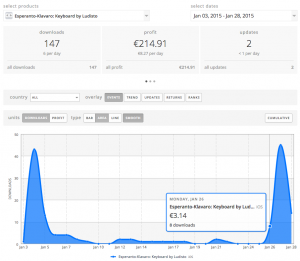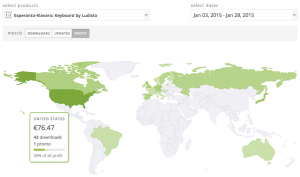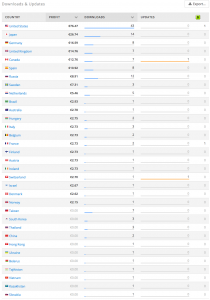The Tale of Two Esperanto iPhone Keyboards Posted by Chuck Smith on Jan 29, 2015 in Esperanto Culture, internet
In September 2014, Apple opened up its mobile operating system, iOS 8 to third-party keyboards. Before this, the Ĝusta Klavaro was available, but it was a separate app where you typed and then copied and pasted its contents to where you wanted them–not very convenient. Due to this new feature of iOS 8, two Esperanto iPhone keyboards were released this month: one by the Esperanto game company, Ludisto, and another by Viacheslav Shklyaev. [Full disclosure: I personally run Ludisto, the creator of the first keyboard.]
Esperanto-Klavaro was released on January 4, 2015 and cost $5. According to an interview with Libera Folio, Shklyaev did not like that this cost $5 and had the Ludisto company logo on it, so he made his own Esperanta Klavaro, released on January 20. It’s also of interest to note that both keyboards used the open source project Tasty-Imitation-Keyboard as a foundation to build them.
Data from my Esperanto venture
On January 27, I made Esperanto-Klavaro free to celebrate the launch of our new iPad board game What the Shell (also playable in Esperanto). I assumed the keyboard would last a little longer as a revenue-generating project, but I don’t regret it. It brought Esperanto keyboards to iPhone owners around the world and earned our company a little, which I can now invest into further developing our Esperanto games. Now that the Esperanto-Klavaro has run its time as a paid app, I’m now delighted to show you the results of this commercial Esperanto venture.
Downloads by Date (Jan 3-28)
Strictly from a business point of view, earning 215€ (US$240) from nine days of work was a pretty big commercial failure, but I was mostly working on it out of idealism, so it doesn’t bother me too much. To put this in perspective, keep in mind that it’s not too unusual for an iOS developer to make 400€ (US$450) per day! In any case, I think it’s interesting to see data from an experimental project just to get a feel for the Esperanto iOS app market.
Downloads by Country
Of course, another interesting statistic is how this breaks down by country. Given that the iPhone’s primary market is the United States, it is no surprise that this is the strongest country by far in sales. I was, however, a little surprised at Japan coming in second place. I was aware that there are many Esperanto speakers there, but I had forgotten how strong the iPhone market is there. In any case, Japan and France usually provide the second and third most participants of the Universala Kongreso de Esperanto (the first is usually the host country), so I suppose this shouldn’t have surprised me so much.
Have you considered pursuing a commercial project in Esperanto? What were your results?
Note: All screenshots were taken from Ludisto’s account on appfigures.com.
Related links
- iOS Esperanto keyboard review: Ĝusta Klavaro (Transparent Language)
- Esperanta klavaro fine ankaŭ por iPhone (in Esperanto: Libera Folio)
- Aperis senpaga Esperanto-klavaro por iPhone (in Esperanto: Libera Folio)
- Esperanto-Klavaro (Apple App Store)
- Esperanta Klavaro (Apple App Store)
- What the Shell (Apple App Store)

Build vocabulary, practice pronunciation, and more with Transparent Language Online. Available anytime, anywhere, on any device.
About the Author: Chuck Smith
I was born in the US, but Esperanto has led me all over the world. I started teaching myself Esperanto on a whim in 2001, not knowing how it would change my life. The timing couldn’t have been better; around that same time I discovered Wikipedia in it’s very early stages and launched the Esperanto version. When I decided to backpack through Europe, I found Esperanto speakers to host me. These connections led me to the Esperanto Youth Organization in Rotterdam, where I worked for a year, using Esperanto as my primary language. Though in recent years I’ve moved on to other endeavors like iOS development, I remain deeply engrained in the Esperanto community, and love keeping you informed of the latest news. The best thing that came from learning Esperanto has been the opportunity to connect with fellow speakers around the globe, so feel free to join in the conversation with a comment! I am now the founder and CTO of the social app Amikumu.







Comments:
Rachel Morris:
I mix it up, I guess.
I’ve been working on ‘Fantazio de Esperanto’ (+ for other languages) that has a free version and a full version for $2.50, but at the same time I also write Open Source Esperanto games for Esperanto Arcade. 😉
I’m going to develop some other games for-sale when I can get around to it as well, and they’ll have full versions for sale, but they’ll be available in English as well as Esperanto (+ other conlangs?), since it doesn’t seem like targeting _just_ Esperantists is really going to bring in that many users or sales – which is why I can see you charging $5 for your keyboard to make the effort ‘worth it’.
And I can also see another programmer saying “yeah right” and writing their own, lol, because that sounds like something I’d be likely to do, haha.
Poster:
One of the reasons I gave up on Esperanto is because because it seems like virtually every Esperantist also speaks English, so its interesting to see Japan in 2nd place.
Chuck Smith:
@Poster Interesting! When I was travelling in Brazil, Russia, Japan and Taiwan, almost none of the Esperanto speakers I met could speak English…
Andy W:
Hi Chuck
I hope you don’t mind me saying this but I do think you priced the keyboard too high. I was following your progress during development but was extremely disappointed when it was launched at £3.99 (IIRC). If £0.79 – definitely, £1.49/1.99 maybe, £3.99 no. I really think you would have made more money by doing this, and if it’s of any interest I would still happily pay the lower price to support you/ludisto.
Sarah:
I’m afraid I got it after it was free! But I have been using it for several days and it’s made learning Esperanto considerably easier. I would love to see a version specifically for iPad, as keyboards designed for iPhone are a bit clunky on the iPad, but other than that it’s great.
Sarah:
ps: also enjoying What The Shell!
Florian:
Hi Chuck,
I wonder, why noone featured the Esperanto keyboard by “MessagEase” yet? Would you give it a try and write a blogpost about it? I think, it’s worth it .)